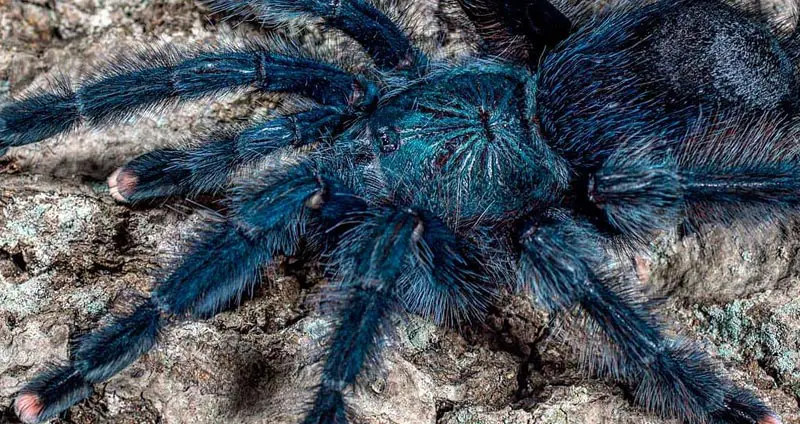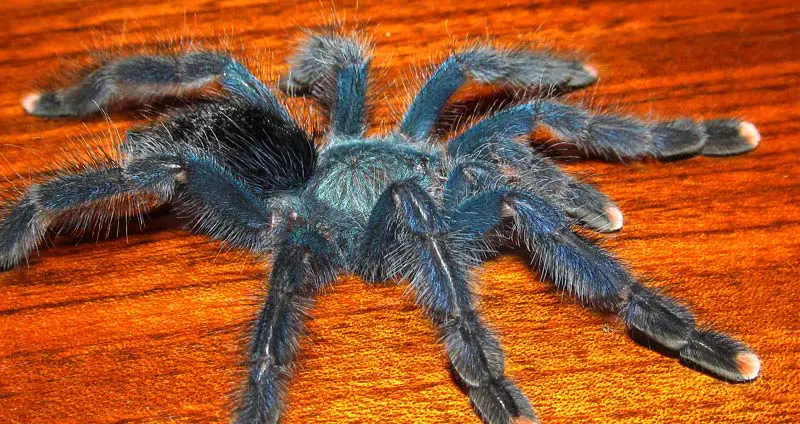The Avicularia genus is frequently referred to as a favorite among tarantula enthusiasts, with Avicularia avicularia being one of the most popular tarantulas today. There are several other species within that genus, though, that combine a great personality with a beautiful appearance and easy care requirements. Avicularia geroldi is definitely one of those species.
Whether you want to know more about this species or you’re looking to bring one home soon, this care sheet will tell you everything that you need to know to become an expert.
Table of Contents
Avicularia geroldi Care Sheet
| | |
Common Name |
Brazilian Blue & Green Pinktoe |
Species Type |
New world arboreal |
Natural Habitat |
Found in the tropical Isle of Santana in Brazil. Commonly found in both green and dead leaves of groves, banana trees, and palm trees. |
Growth Rate |
Medium-to-fast growth rate. Females and males can reach full size within 2 years. |
Adult Size |
Females reach a legspan of between 5″ and 6″, with males measuring slightly smaller. |
Lifespan |
Females regularly live to 12 years, while males often only live to 3 years. |
Enclosure |
The enclosure should be taller than it is wide, with plenty of materials to climb on and attach webbing to. Two inches of substrate should line the floor, and water should always be available. The enclosure should have good airflow. |
Temp/Humidity |
78°F to 82°F with about 60% to 70% humidity. |
Diet |
Good eater that can eat several adult-sized crickets per week. Dubia roaches and mealworms should be used as supplemental food. |
Temperament |
Relatively docile. Rarely flicks hairs (Usually rubs hairs into its webs) and virtually never bites. Can be a bit skittish, though. |
Experience Level |
Intermediate – Relatively easy to care for with a good temperament. However, it can be fairly tricky to maintain the correct humidity levels. |
Average Cost |
Slings ~ $30, Males ~ $75, Females ~ $125+ |
Avicularia geroldi Appearance
When considering the appearance of this tarantula, one only needs to look at its common name: Brazilian Blue & Green Pinktoe. Adults are a deep blue color that looks almost iridescent in direct sunlight. Its abdomen is near-black with a subtle blue coloration to it as well. The tips of its legs feature the characteristic pink toes that several other Avicularia tarantulas have.
This coloration isn’t consistent throughout their lives, though. Spiderlings start out quite different. These babies have black feet, beige legs, and a red pattern on the top of their abdomen. They won’t be like this for long, though, as A. geroldi has a medium-to-fast growth rate with males maturing in as little as 2 years.
In terms of sizing, this is an average tarantula. Adult females reach between 5 and 6 inches in legspan with males being a bit smaller. To reach this size, this species will molt several times. fortunately, its colors are most vivid right after a molt, so you’ll get a nice spectacle several times over the course of your ownership.


via @arthur_spiderwick / Instagram
Avicularia geroldi Temperament
The overall temperament of this tarantula and most tarantulas within the Avicularia genus is what makes them so highly-praised. This is an arboreal species, meaning that it lives in trees and rarely walks on the ground. Because of this, they’ve become quite agile over the years — but don’t let this scare you away!
In captivity, Avicularia geroldi is a very docile tarantula that makes for an optimal pet. It’s a new world tarantula, which are tarantulas that are known for being laid-back, more forgiving, and preferring to take flight over fight when faced with a predator. Essentially, new world tarantulas are much easier to care for and are thus recommended for inexperienced keepers.
While they are laid-back, it isn’t recommended that you handle this tarantula (or any tarantula for that matter). This particular species does have a tendency to act a bit skittish whenever their enclosure is being accessed. They won’t bite, but this can result in some unpredictable outcomes. Aside from biting, this species has another effective defense.
As new world tarantulas, this species possesses urticating hairs, which are essentially barbed hairs that can cause severe irritation to predators. While many tarantulas flick these hairs at their attacker, Avicularia geroldi actually rubs their hairs into the webbing in their enclosure! Therefore, be very cautious when accessing their cage — these hairs are no joke.
Overall, though, this is a relatively relaxed tarantula that almost never throws up threat poses or acts defensively.
Housing Avicularia geroldi
If you’re planning on bringing an Avicularia geroldi home, you need to be sure that you’re meeting all of their environmental needs through their enclosure. It’s also important that you build an enclosure that doesn’t need to be interacted with a lot because this tarantula is a little bit skittish and doesn’t enjoy a lot of interaction.
This species hails from Brazil — specifically the Isle of Santana. This tropical environment is quite warm year-round and has a decent amount of humidity. Because of this, the optimal enclosure for this species is kept around 80°F with about 60%-70% humidity.
Optimal Enclosure
This tarantula does have specific needs for their enclosure, but those needs aren’t difficult to meet at all. First of all, this is an arboreal tarantula species that spends most of its time in trees above the ground. It often creates webs that it stays in and uses sticks and other natural materials as anchor points.
Due to this behavior, it’s essential that you supply your Avicularia geroldi with an enclosure that’s at least as tall as it is wide. This will give it plenty of room to create webs and feel comfortable and secure.
It’s extremely important to note that airflow is very important for this tarantula species. If there is poor airflow and the enclosure is kept too moist, it can result in premature death. Fortunately, this Exo Terra 12″x12″x12″ terrarium makes for a breathable and accessible enclosure.
The inside of the enclosure should be crafted for arboreal tarantulas. This involves covering the floor with about 2 inches of moisture-retaining substrate, then filling the enclosure with sticks, fake plants and leaves, and cork bark for an effective tarantula hide. There should be a lot of anchor points of A. geroldi’s webbing and many places to hide.
It’s also very important to include a water bowl at the bottom of the enclosure. Not only do tarantulas drink water to stay hydrated, but it also helps to regulate humidity within the enclosure.
Part of practicing good husbandry is keeping a close eye on the enclosure’s temperature and humidity. Heat lamps or space heaters can be used to bring the enclosure’s temperature up to optimal levels, and misting the enclosure occasionally will keep humidity levels up.
Avicularia geroldi Diet
These tarantulas are pretty normal when it comes to their eating habits. They readily attack many different foods that are placed within their enclosure. Crickets and dubia roaches are the best foods for this tarantula, with mealworms acting as a great treat.
Spiderlings of this species should be fed either flightless fruit flies due to their small size, or 1/4″ crickets. As they grow larger, you can start to feed them 1″ crickets several times per week. House geckos and pinky mice are nice treats that can be fed once every couple of months.
Some owners run into the problem of not experiencing their tarantulas eating right away due to the fact that they stay hidden away in their webs. Don’t worry if this happens! While tarantulas may not be capable of complex thought, they will absolutely pursue food if they’re hungry. Thus, avoid dropping prey into web tunnels or hides.
Health Issues
As stated, this is not a very difficult tarantula to care for — a common trend among the Avicularia genus. They’re quite hardy and thrive when kept in the proper conditions and fed a good diet. Two main health issues plague captive tarantulas, and those are dehydration and mites/parasites. However, both of these problems are easily avoided/dealt with.
Two things should be noted with this species. First of all, it’s very sensitive to humidity and lack of airflow. A stuffy enclosure is the #1 cause of premature death with this species, especially in their sling stage. Therefore, it’s very important to be sure that the enclosure is breathable and isn’t kept at too high of a humidity level.
Additionally, every tarantula can potentially run into problems with its molt. If the temperature and humidity are kept at good levels, then it should happen flawlessly. However, the potential for problems is there.
If your tarantula gets stuck during a molt, you’ll need to help them complete it. Fortunately, there are a lot of guides online that walk you through exactly what to do in this case.
Purchasing Avicularia geroldi
This tarantula very middle of the road when it comes to pricing. Its high desirability, ease of care, and great appearance make it quite popular, so they’re relatively easy to find and overall very affordable.
There are several online marketplaces and breeders that sell Avicularia geroldi for a variety of different prices. Spiderlings regularly sell for around $30 – $40, with sexed males selling for between $50 – $100 and females reaching $125+. These prices typically include shipping and a safe arrival guarantee.
Overall, this is a tarantula that’s well worth $100. It has such a beautiful appearance that’s unrivaled by many other tarantula species. It’s also quite easy to care for and has a temperament that makes it very fun to own. There’s a reason why tons of tarantula enthusiasts love this genus!

